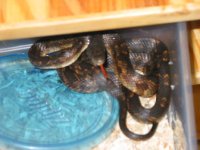JaketheTick
New member
Ok, a buddy of mine found a snake in his shop, and let me have it....he's no snake enthusiast, but was confused as heck because he couldnt figure out what it was....figured i would know..i said sure...i can tell you...hmmm....maybe not...heres the best i can do at a description (until my slack self gets a pic on here, which will be soon) its about 2 1/2 feet long...built more like a black rat than a corn( yeah...there is a slight difference)...has grayish eyes like a black rat...a bright red tongue like ive seen in black rats...a head shaped more like a black rats.. but...its almost like the markings of a youth rat snake, you know the saddles and all like a corn..but theres a lot of yellow and orange and red in them....not quite like a corn..to be honest, it almost looks like a canebrake as far as the shades go, but the pattern is definitely rat snake/corn.... it basically looks like either a really dark corn, or a very oddly colored black rat...id say its dead in the middle of the two...is that a possible mix? Anybody seen one before? Im thinking about a few breeding trials to see what i come up with...it really is and interesting coloration.


